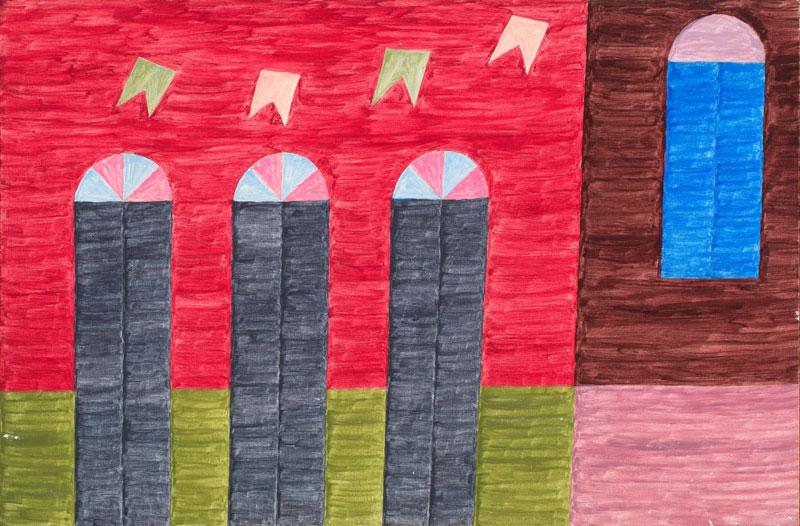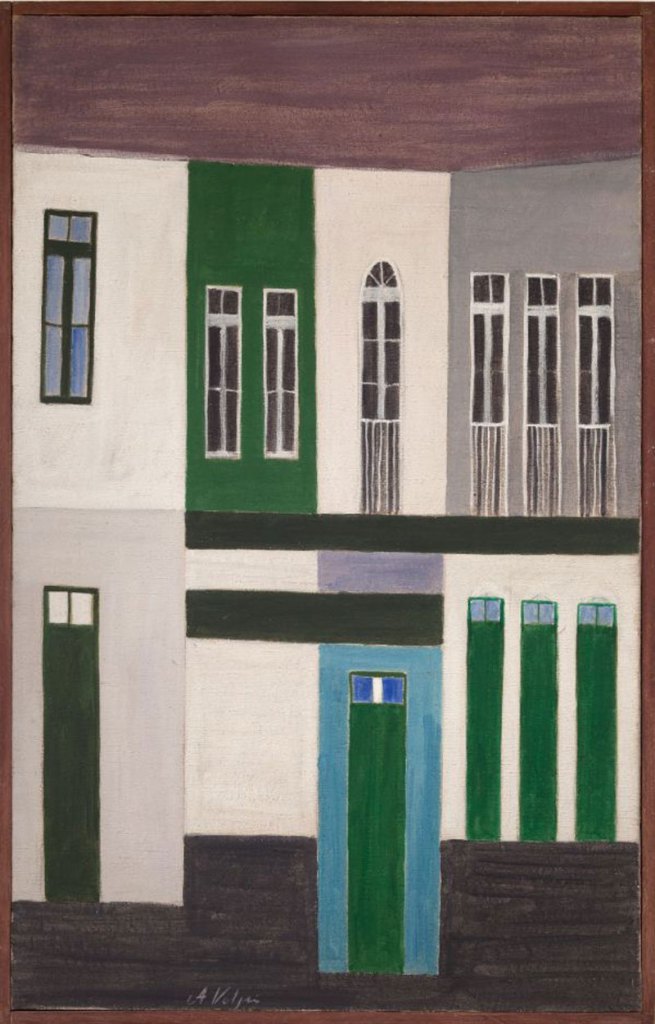Last week, down a side alley on an industrial estate in Bermondsey, just yards from White Cube, Cecilia Brunson Projects opened a small but vivid exhibition of works by the Italian-born, Brazilian painter Alfredo Volpi (1896–1988). While Volpi’s name may be unfamiliar to many in England, in Brazil he is a cultural hero. He started out in São Paolo as a typographer, interior decorator, and self-taught painter of murals, before beginning in 1914 to experiment with oils – carefully observed landscapes and everyday scenes. But it was his encounter in the early 1930s with other immigrant artists, including Mario Zanini, Manuel Martins, Humberto Rosa, and Fulvio Pennacchi, who together formed the Grupo Santa Helena, that transformed his sense of direction.
From there, his almost flat, almost abstract works, with their contrasting planes of colour and reminiscences of doorways and cheerful bunting, provided Brazilian artists with a bridge between the bright, figurative paintings of Brazilian modernists such as Emiliano di Cavalcanti and Tarsila do Amaral and the geometric abstraction of the 1950s Neo-Concrete movement and Grupo Ruptura. Volpi, however, who was allied at different times with different vociferous factions, and revered by the many ‘volpistas’ in Brazil who championed his work, remained dedicated to his own evolution: ‘…I never think about what I am doing, I think only about the problem of the line, of the shape of colour,’ he once said.
Fachada e elementos de fachadas (1980s), Alfredo Volpi. Courtesy Cecilia Brunson Projects

Volpi’s work toured Britain as early as 1944 in the group show ‘Modern Brazilian Paintings’ and, in 1953, the British critic Herbert Read invited him on to the jury of the second São Paolo Biennial. Read insisted that Volpi be awarded the national painting prize, alongside Cavalcanti, for a work on show here, (Untitled, 1940s–50s). Yet this is the first solo exhibition in the UK of this highly influential figure. It is the second of a series of three exhibitions this year, entitled ‘Three Perspectives of Modern and Contemporary Art from Brazil’, curated by the independent Chilean curator, Cecilia Brunson in collaboration with Almeida e Dale Gallery in São Paulo. It represents a further stage in Brunson’s efforts to introduce British and European audiences to the best of Latin American art. Some work will be for sale, with prices from $250,000 up to $5 million.
Untitled (1953), Alfredo Volpi. Courtesy Cecilia Brunson Projects

Brunson is not the only one raising the profile of Latin American art. Several exhibitions in public institutions – Tate Modern’s Frida Kahlo exhibition in 2005, the Royal Academy’s tremendous ‘Radical Geometry: Modern Art of South America from the Patricia Phelps de Cisneros Collection’ in 2014, and two Saatchi Collection initiatives, ‘Tectonic Shift: Contemporary Art from Chile’ (2011), curated by Brunson, and ‘Pangaea: New Art from Africa and Latin America’ – have drawn attention to the history and vivacity of art-making on the continent. Tate has been buying in the region and opens an exhibition of the work of Cuban modernist Wifredo Lam in September. And while the Latin American art market may have a faltered a little in 2015 after the boom year of 2014, with collectors perhaps made nervous by Brazil’s weakening economic performance, this is still a young market; Sotheby’s, Christie’s, and Phillips have been working assiduously to feed the new interests of both collectors and institutions. Commercial galleries in London have also been dipping a toe in the market, with Lisson’s show of work by Brazilian sculptor Sergio Camargo (1930–90) and Michael Hoppen’s survey of Latin American photography taking place last year, while Pinta London offers an annual showcase of Latin American galleries.
‘Under the Same Sun: Art from Latin America Today’ at South London Gallery, 2016. Photo: Andy Stagg. Courtesy Solomon R. Guggenheim Foundation and the South London Gallery

Also last week, just up the road from Bermondsey, the South London Gallery opened its summer show, ‘Under the Same Sun: Art from Latin America’ (until 11 September). This pioneering collaboration with the Guggenheim presents works recently acquired by the American museum as part of its global acquisitions programme, ranging across the whole of Latin America. It includes more than 40 artists working across installation, video, sculpture, painting, and photography. The show is a mixed but stimulating bag, with a strong political thread, and spills out from the main galleries into the derelict but soon to be renovated former Peckham Road Fire Station. Reaching further out into the local community, Costa Rican artist Federico Herrero has transformed the playground of a local housing estate with vibrant patches of colour – bringing the Latin American sun into the heart of Peckham.
‘Alfredo Volpi: At the Crossroads of Latin American Art’ is at Cecilia Brunson Projects, London, until 29 July.
‘Under the Same Sun: Art from Latin America’ is at the South London Gallery until 11 September.


